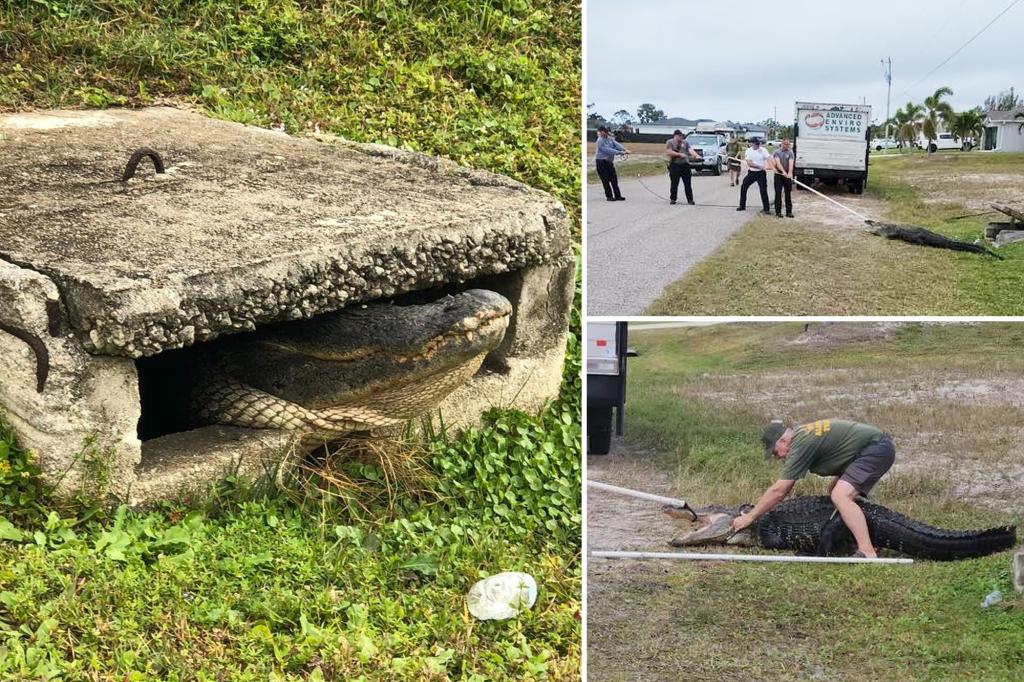The sleepy city of Cape Coral, Florida, experienced a real-life echo of the 1980s horror film “Alligator” on a seemingly ordinary Sunday. A mammoth gator, measuring over ten and a half feet in length, had become inexplicably wedged within a narrow storm drain, its snout the only visible evidence of its predicament. Unlike its fictional counterpart in the B-movie, this real-life reptile’s escapade didn’t involve preying on unsuspecting waitresses or terrorizing local politicians. Instead, it prompted a dramatic rescue operation involving a team of six firefighters and a wildlife trapper, showcasing a blend of bravery, ingenuity, and community spirit.
The incident began with a chance sighting by a passerby who spotted the alligator’s snout protruding from the storm drain opening. Recognizing the potential danger and the unusual nature of the situation, the observer promptly alerted the authorities. The Cape Coral Fire Department responded swiftly, deploying a crew equipped to handle the unique challenge. Upon arrival, the firefighters assessed the situation and devised a plan to extract the massive reptile from its confined space. The operation was not without its complexities; the culvert lid was heavy and securely fastened, and the alligator’s formidable jaws posed a significant risk.
The firefighters employed a winch attached to their brush truck, a vehicle designed for tackling various emergencies, to lift the weighty culvert lid. This created an opening for a trapper from the Fish and Wildlife Commission to carefully maneuver a hook around the gator’s powerful jaws. With the gator secured, the firefighters, working in coordinated effort, hauled the massive creature out of the drain, a feat showcasing their strength and teamwork. The rescued reptile, now free from its concrete prison, was carefully loaded into a pickup truck, marking the end of its unexpected urban adventure.
The alligator’s subsequent fate was far removed from the gruesome demise of its cinematic counterpart. Instead of wreaking havoc on the city, the rescued reptile was transported to an alligator farm, a sanctuary where it could live out its days in a more natural environment. The fire department, in a Facebook post detailing the incident, even hinted at the possibility of the gator being introduced into a breeding program, a positive outcome that contrasts sharply with the creature’s perilous predicament. This humane approach underscores a commitment to wildlife conservation and a recognition of the importance of these creatures within the ecosystem.
The incident, while dramatic, also prompted reflection on the interconnectedness of urban environments and natural habitats. The storm drain where the alligator was found is situated near the Yucca Pens Unit State Wildlife Management Area, suggesting that the reptile may have wandered from its natural habitat. While the exact circumstances of how the alligator ended up in the drain remain a mystery, the proximity of the wildlife area offers a plausible explanation. The incident serves as a reminder of the unexpected encounters that can occur in areas where urban development encroaches upon natural territories.
The Cape Coral Fire Department’s response to the incident, characterized by professionalism and a touch of humor, reflected the community’s appreciation for their efforts. The department’s Facebook post not only detailed the rescue but also expressed their commitment to serving the community, emphasizing the unpredictability of their work. The event, while highlighting the potential dangers associated with wildlife encounters, also showcased the readiness and resourcefulness of local first responders, reaffirming the vital role they play in safeguarding both human and animal lives. The successful rescue of the giant gator, far from being a scene ripped from a horror movie, became a testament to community cooperation and the dedication of those who serve.










